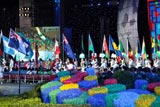Symbol of reform, Shenzhen still appeals to youths
Updated: 2011-08-11 16:09
(Xinhua)
SHENZHEN - When Ye Ping finished his service in the People's Liberation Army eight years ago, the 26-year-old had to make a potentially life-changing decision: to stay in his hometown in central China's Henan province or move to Shenzhen.
Ye decided to move and joined tens of thousands of migrants heading to the southern boomtown, just like thousands of trailblazers did three decades ago when the Chinese government selected Shenzhen as one of the five special economic zones to spearhead the country's market-oriented reform and opening-up experiment.
"At first, I just wanted to create my business in Shenzhen because it would offer me more opportunities," said Ye, who now works as a medical councillor for a Japanese-funded company in Shenzhen.
"All I dreamed about then was very simple - buy a house, get a car and have a family," he said.
Lured by opportunities, Ye and more than 6 million other migrant workers and entrepreneurs have flocked to Shenzhen over the past 10 years, raising its population to about 13 million from 7 million 10 years ago.
When the Shenzhen Special Economic Zone was established in 1980, the city had a population of some 300,000.
Starting from a small village 31 years ago, Shenzhen has been the fastest growing Chinese city in the past three decades, with numerous skyscrapers and an economy the size of 146.3 $billion in 2010, ranking only after Shanghai, Beijing and Guangzhou.
"Among all major cities in China, I think Shenzhen is the most energetic and creative that attracts talents from across the country," said Zhang Wen, vice-mayor of Shenzhen in a recent interview. Zhang was born in East China's Jiangxi province and began working in Shenzhen after college graduation in 1991.
"Shenzhen is a young city, with people from the country's 56 ethnic groups living here," Zhang said. More than 200,000 overseas citizens from 100 countries or regions live in Shenzhen, too.
According to data from the sixth population census, the average age of people living in Shenzhen is around 30, with people aged between 15 to 65 accounting for 88.4 percent of the city's total population.
"Failures are tolerated and creativity favored in Shenzhen," said the vice mayor. "Anyone is encouraged to start from zero here and realize one's dreams."
For Beijing Genomics Institute (BGI), a Chinese genetic research leader who successfully sequenced 1 percent of the human genome for the International Human Genome Project and other genome programs, Shenzhen is the right place for developing projects and platforms that are on the cutting edge of research and technologies. The organization relocated its headquarters from Beijing to Shenzhen in 2007.
"As we see it, tolerance and aggressiveness have been the soul of Shenzhen since the establishment of the special economic zone," said Wang Jian, president of the BGI (Shenzhen). "People here don't argue about ideology and they won't give up things they deem right."
According to the organization, BGI (Shenzhen) has a young research team with researchers' average age standing at 25.
Apart from BGI, leading companies from other industries, such as China's largest telecommunication equipment manufacturers Huawei, the Internet giant Tencent, automaker BYD and real estate developer Vanke also have set up their headquarters in Shenzhen.
Rising property prices, however, may discourage many young people from working in Shenzhen, where home prices match those in Shanghai and Beijing.
After working eight years in Shenzhen, Ye said he was pleased he decided to settle down in the city rather than his hometown. "I was lucky to buy an apartment in Shenzhen before the prices surged and my dreams to have a family and an apartment of my own have already come true," he said.
Ye attributed his easy integration into life in Shenzhen to being a member of the city's well-organized volunteer group, whose registered members top 250,000.
"A very young city itself, Shenzhen offers very good opportunities for young people with its emphasis on youth culture, " said Zhang Zhihua, deputy director of the Volunteer's Office for the 26th Summer Universiade, which kicks off on Friday.
"At the very beginning, Shenzhen was famous for its culture emphasizing the development speed and migrant workers. And now it gives more attention to its youths," Zhang said.
Related Stories
Shenzhen Universiade ready for unique opening ceremony 2011-08-11 14:10
Video

Working as a Universiade volunteer

Party starts as Universiade ends

Sumptuous seafood in Shenzhen

Athletes test doping knowledge
About Shenzhen

